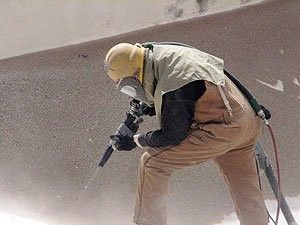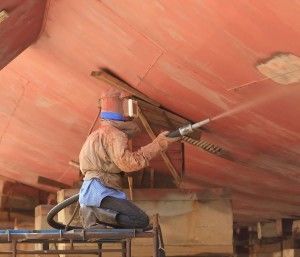The most widely-used surface preparation standards in use are the following:
- Swedish Standards (Sa, St),
- Steel Structures Painting Council (SSPC) standards and
- National Association of Corrosion Engineers (NACE) standards.
Definitions for surface preparation
Near-White Blast Cleaned Surface:
A Near-White Blast Cleaned Surface finish is defined as a surface finish from which all oil, grease, dirt, mill scale, rust, corrosion products, oxides, paint or other foreign matter have been completely removed from the surface except for very light shadows, very slight streaks or slight discolorations caused by rust stain, mill scale oxides, or light, tight residues of paint or coating that may remain. At least 95 percent of each square inch of surface area shall be free of all visible residues, and the remainder shall be limited to the light discoloration mentioned above.
White Metal Blast Cleaned Surface:
A White Metal Blast Cleaned Surface finish is defined as a surface finish with a gray-white, uniform metallic color, slightly roughened to form a suitable anchor pattern for coatings. The surface, when viewed without magnification, shall be free of all oil, grease, dirt, visible mill scale, rust, corrosion products, oxides, paint, or any other foreign matter.
Commercial Blast Cleaned Surface:
A Commercial Blast Cleaned Surface finish is defined as a surface finish from which all oil, grease, dirt, rust scale and foreign matter have been completely removed from the surface and all rust, mill scale and old paint have been completely removed except for slight shadows, streaks, or discolorations caused by rust stain, mill scale oxides or slight, tight residues of paint or coating that may remain. At least two-thirds of each square inch of surface area shall be free of all visible residues and the remainder shall be limited to the light discoloration, slight staining or tight residues mentioned above.
STANDARDS:
1. Swedish standards surface preparation categories
Six major categories exist in accordance with Swedish standards:
– St 2: Hand tool cleaning
– St 3: Power tool cleaning
– St 4: Brush-off blast cleaning
– Sa 2: Commercial blast cleaning
– Sa 2 1/2: Near-white blast cleaning
– Sa 3: White metal blast cleaning
- NACE surface preparation standards categories
Three major categories exist in accordance with NACE standards:
– NACE 1: White metal blast cleaning
– NACE 2: Near-white metal blast cleaning
– NACE 3: Commercial blast cleaning
- SSPC surface preparation standards categories
Ten major categories exist in accordance with SSPC standards:
– SP-1: Solvent cleaning
– SP-2: Hand-tool cleaning
– SP-3: Power tool cleaning
– SP-4: Flame cleaning
– SP-5: White metal blast cleaning
– SP-6: Commercial blast cleaning
– SP-7: Brush-off blast cleaning
– SP-8: Pickling
– SP-9: Weathering followed by blast cleaning
– SP-10: Near-white blast cleaning
Cleaning Methods:
- Hand tool cleaning methods involve use of hand wire brushing, hand scraping, hand chipping or use of other hand impact tools.
- Power tool cleaning methods employ power wire brushes, power impact tools, power grinders, power sanders or a combination of these tools.
- Solvent cleaning methods involve use of solvents, emulsions, cleaning compounds or other similar materials.
- Flame cleaning methods typically make use of high temperature, high velocity oxy-acetylene flame over the entire surface, usually followed by wire brushing.
- Pickling methods typically make use of chemical reaction, electrolysis or both.
- Near-white blast cleaning, white metal blast cleaning and commercial blast cleaning methods typically use abrasives propelled through nozzles or by centrifugal wheels.

Leave a Reply